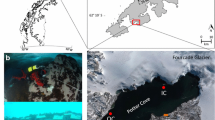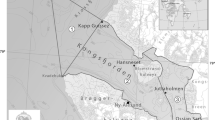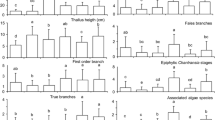Summary
From October 10, 1979 to August 26, 1981 we investigated the effect of physical disturbance, herbivory and algal-algal competition on the dynamics of the Macrocystis community near Valdivia, Chile. The most abundant herbivore, Tegula atra, was continuously removed from one of two sites with high initial Tegula density (control and Tegula-removal rocks) and added to one of two sites where Tegula was initially absent (Tegula-addition and addition-control rocks). Macrocystis was rare at the beginning of the study. From October 1980 to April 1981 we continuously removed Macrocystis from an additional rock near the addition-control rock. On each site the response of the algal community was monitored by photographing 9, 0.25 m2 permanent quadrats at 2–4 week intervals.
Tegula had little effect on Macrocystis and there were no other important herbivores present. Each summer Macrocystis dominated all 4 sites of the Tegula experiment and Tegula migrated towards the intertidal to feed. Macrocystis was reduced each winter by winter storms, the holdfasts (but not the canopy) surviving the first winter but not the second. The Macrocystis removal rock was dominated by lower growing perennial algae, indicating a competitive hierarchy among the algae of the form: Macrocystis>perennial algae>ephemeral algae>encrusting algae.
Except for the presence of a competitive hierarchy among the algae and the importance of winter storms, Chilean kelp communities share few of the organizational features of their northern hemisphere counterparts. Marine mammals (excluding man) do not prey on algal consumers (Tegula and the urchin, Loxechinus albus) and these consumers have little effect on perennial macroscopic algae. Urchins apparently feed only on drift algae. Species richness in the algal community is low.
Similar content being viewed by others
References
Breen PA, Mann KH (1976a) Destructive grazing of kelp by sea urchins in eastern Canada. J Fish Res Bd Canada 33:1278–1283
Breen PA, Mann KH (1976b) Changing lobster abundance and the destruction of kelp beds by sea urchins. Mar Biol 34:137–142
Castilla JC, Bahamondes I (1979) Observaciones conductuales y ecologicas sobre Lutra felina (Molina 1978) (Carnivora; Mustelidae) en las zonas Central y Centro-Norte de Chile. Arch Biol Med Exper 12:119–132
Castilla JC, Moreno CA (1981) Sea urchins and macroalgae: an experimental test of their ecological relations in southern Chile. Proc Inter Echinoderm Conf, Tampa, Florida (USA)
Chapman ARO (1981) Stability of sea urchin dominated barren grounds following destructive grazing of kelp in St. Margaret's Bay, Eastern Canada. Mar Biol 62:307–311
Dayton PK (1974) Kelp communities of southern South America. Antarctic Journal of the U.S. 9:22–23
Dayton PK (1975) Experimental studies of algal canopy interaction in a sea-otter dominated kelp community at Amchitka Island, Alaska. Fish Bull 73:230–237
Dayton PK, Rosenthal RJ, Mahan LC (1973) Kelp communities in the Chilean archipelago: R/V Hero Cruise 72-5. Antarctic Journal of the U.S. 8:34–35
Dayton PK, Rosenthal RJ, Mahan LC, Antezana T (1977) Population structure and foraging biology of the predaceous Chilean asteroid Meyenaster gelatinosus and the escape biology of its prey. Mar Biol 39:361–370
Duggins DO (1980) Kelp beds and sea otters: an experimental approach. Ecology 61:447–453
Duggins DO (1981) Interspecific facilitation in a guild of benthic marine herbivores. Oecologia 48:157–163
Estes JA, Palmisano JF (1974) Sea otters: their role in structuring nearshore communities. Science 185:1058–1060
Estes JA, Smith NS, Palmisano JF (1978) Sea otter predation and community organization in the western Aleutian Islands, Alaska. Ecology 59:822–329
Foster MS (1975) Algal succession in a Macrocystis pyrifera forest. Mar Biol 32:313–329
Illies H (1970) Geología de los alrededores de Valdivia y Volcanismo y tectonica en margenes del Pacífico en Chile Meridional. Pub Fac Ciencias Nat Mat Univ Austral de Chile. Valdivia. 64 pp
Jara HF, Moreno CA (1982) Herbivory and structure in a midlittoral rocky community: a case in southern Chile. Submitted to Ecology
Lawrence JM (1975) On the relationships between marine plants and sea urchins. Oceanogr Mar Biol Ann Rev 13:213–286
Leighton DL (1971) Grazing activities of benthic invertebrates in southern California kelp beds. Beih Nova Hedwigia BD 43:421–453
Lubchenco J, Cubit J (1980) Heteromorphic life histories of certain marine algae as adaptations to variation in herbivory. Ecol 61:676–686
Mann KH (1977) Destruction of kelp beds by sea urchins: a cyclical phenomenon or irreversible degradation. Helgolander wiss Meeresunters 30:455–467
Mattison JE, Trent JD, Shanks AL, Akin TF, Pearse JS (1977) Movement and feeding activity of red sea urchins (Strongylocentrotus franciscanus) adjacent to a kelp forest. Mar Biol 39:25–30
Moreno CA, Duarte WE, Zamorano JH (1979) Variacíon latitudinal del número de especies de peces en el sublitoral rocoso: una explicación ecológica. Arch Biol. Med Exp 12:169–178
Paine RT (1977) Controlled manipulations in the marine intertidal zone, and their contributions to ecological theory. pp 245–270. In: Changing Scenes in the Natural Sciences, 1976. Academy of Natural Sciences, special publication 12
Paine RT, Levin SA (1981) Intertidal landscapes: disturbance and the dynamics of pattern. Ecol Monogr 51:145–178
Paine RT, Vadas RL (1969) The effects of grazing by sea urchins, Strongylocentrotus spp. on benthic algal populations. Limnol and Oceanog 14:710–719
Pearse JS, Hines AH (1979) Expansion of a central California help forest following the mass mortality of sea urchins. Mar Biol 51:83–91
Ramirez C, Godoy R, Contreras D, Rivera P (1981) Guía de algas marinas Valdivianas. Central de Publicaciones, Universidad Austral de Chile, Valdivia
Rosenthal RJ, Clarke WD, Dayton PK (1974) Ecology and natural history of a stand of giant kelp, Macrocystis pyrifera of del Mar California. Fish Bull 72(3):670–684
Santelices B (1980) Phytogeographic characterization of the temperate coast of Pacific South America. Phycologia 19(1):1–12
Simenstad CA, Estes JA, Kenyon KW (1978) Aluets, sea otters, and alternate stable state communities. Science 200:403–411
Slocum CJ (1980) Differential susceptibility to grazers in two phases of an intertidal alga: advantages of heteromorphic generations. J Exp Mar Biol Ecol 46:99–110
Sokal RR, Rohlf J (1969) Biometry. WH. Freeman, San Francisco, USA
Vadas RL (1968) The ecology of Agarum and the kelp bed community. Ph.D. Thesis, University of Washington
Vadas RL (1977) Preferential feeding: an optimization strategy in sea urchins. Ecol Monog 47:337–371
Westermeier R, Ramirez C (1979) Artendiversitat und nekromasse der algen im strandanwurf von Niebla (Valdivia, Chile). Bot Mar 22:241–248
Zamorano JH, Moreno CA (1975) Communidades bentónicas del sublitoral rocoso de Bahía de Corral. I. Área mínima de muestreo y descripción cuantitativa de la asociación de Pyura chilensis (Molina). Medio Ambiente 1:58–66
Author information
Authors and Affiliations
Rights and permissions
About this article
Cite this article
Moreno, C.A., Sutherland, J.P. Physical and biological processes in a Macrocystis pyrifera community near Valdivia, Chile. Oecologia 55, 1–6 (1982). https://doi.org/10.1007/BF00386710
Received:
Issue Date:
DOI: https://doi.org/10.1007/BF00386710




